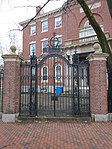Lyman Laboratory of Physics
AC with 0 elementsHarvard UniversityMassachusetts building and structure stubsPhysics laboratoriesUniversity and college laboratories in the United States
The Lyman Laboratory of Physics (named for the physicist Theodore Lyman) is a building at Harvard University located between the Jefferson and Cruft Laboratories in the North Yard. It was built in the early 1930s, to a design by Coolidge, Shepley, Bulfinch and Abbott.Among those who have done research at Lyman are Sheldon Glashow, Higgins Professor of Physics, Emeritus and Richard Wilson, Mallinckrodt Professor of Physics, Emeritus. Here, Ranga Dias (Post-Doctoral Fellow) and Isaac F. Silvera (Thomas D. Cabot Professor of the Natural Sciences) claim to have gathered experimental evidence that solid metallic hydrogen had been synthesised.
Excerpt from the Wikipedia article Lyman Laboratory of Physics (License: CC BY-SA 3.0, Authors).Lyman Laboratory of Physics
Massachusetts Avenue, Cambridge
Geographical coordinates (GPS) Address Nearby Places Show on map
Geographical coordinates (GPS)
| Latitude | Longitude |
|---|---|
| N 42.37753 ° | E -71.11713 ° |
Address
Harvard University
Massachusetts Avenue
02138 Cambridge
Massachusetts, United States
Open on Google Maps










